bkd
This local Chesapeake Bay Lure is a favorite of the local Anglers. Used with any jig head, it is a highly effective lure for multiple species.
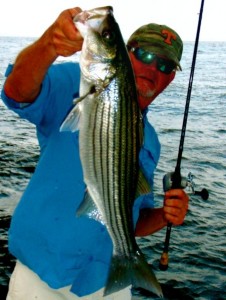 Okay, so this entry might be a little heavy on the fireworks and light on the rockfish. That’s because I’m not too good at fishing in crowds, so I spent most of last weekend doing chores around the house. That’s not to say I didn’t get some time in on the water. In fact, I don’t think I missed a day, but most of my time on Thunder Road was spent cruising to fireworks shows around Kent Island. Since this is a fishing website, I’ll start with a catching report. I met Rich at Sandy Point State Park Friday afternoon for a few minutes of piling picking onboard his 19′ Sea Hunt center console. There was very little wind but plenty of boat wakes, so we took our time getting to the our fishing spots. We had a ripping outgoing current so we rigged up soft plastic lures on three-quarter ounce jig heads. I was throwing a hotrodded white 6″ BKD and Rich had on some kind of chartreuse lure I didn’t recognize. I think we caught keeper size stripers on our first four casts, so we could have had a 5-minute limit. We stayed with it for two and a half hours and released 27 keepers with plenty of shorts. We caught on both the east and west sides of the bridge, even sneaking in downstream of some bored-looking live-liners who didn’t seem to share our amusement when we pulled nice fish right out from under the pilings where they were anchored. Read More!
Okay, so this entry might be a little heavy on the fireworks and light on the rockfish. That’s because I’m not too good at fishing in crowds, so I spent most of last weekend doing chores around the house. That’s not to say I didn’t get some time in on the water. In fact, I don’t think I missed a day, but most of my time on Thunder Road was spent cruising to fireworks shows around Kent Island. Since this is a fishing website, I’ll start with a catching report. I met Rich at Sandy Point State Park Friday afternoon for a few minutes of piling picking onboard his 19′ Sea Hunt center console. There was very little wind but plenty of boat wakes, so we took our time getting to the our fishing spots. We had a ripping outgoing current so we rigged up soft plastic lures on three-quarter ounce jig heads. I was throwing a hotrodded white 6″ BKD and Rich had on some kind of chartreuse lure I didn’t recognize. I think we caught keeper size stripers on our first four casts, so we could have had a 5-minute limit. We stayed with it for two and a half hours and released 27 keepers with plenty of shorts. We caught on both the east and west sides of the bridge, even sneaking in downstream of some bored-looking live-liners who didn’t seem to share our amusement when we pulled nice fish right out from under the pilings where they were anchored. Read More!
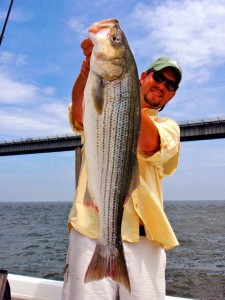 Have you heard? Light tackle casting is producing big fish lately on the Chesapeake Bay. Some lucky anglers are catching fish over 30-inches on almost every trip. Sometimes they get three or four. Most of the fish I’m catching are coming off cover like rocks or bridge pilings, but some have been hooked while fishing submerged structure in open water. Both soft plastics and metal jigs are producing. If you’ve been out, I hope you’re enjoying some lucky days. 30-inch plus stripers in late June is something to celebrate, especially considering how tough fishing has been previously.
Have you heard? Light tackle casting is producing big fish lately on the Chesapeake Bay. Some lucky anglers are catching fish over 30-inches on almost every trip. Sometimes they get three or four. Most of the fish I’m catching are coming off cover like rocks or bridge pilings, but some have been hooked while fishing submerged structure in open water. Both soft plastics and metal jigs are producing. If you’ve been out, I hope you’re enjoying some lucky days. 30-inch plus stripers in late June is something to celebrate, especially considering how tough fishing has been previously.
In my opinion, seasoned anglers make a lot of their own luck. Since the fish are more inclined to bite now, I thought it might be worthwhile to discuss tips for hooking and landing bigger fish – just some little things that can move fishermen up from the usual summer schoolies to true summer trophies. You probably have a few tips as well, so feel free to share them in the comments section. I’ll start with the basics: Read More!
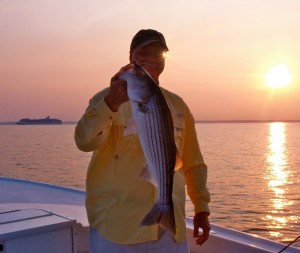 Channel catfish at Hackett’s Bar, carp at the Bay Bridge, snakeheads in St. Jerome’s Creek, and very few stripers in their usual haunts around Kent Island – what’s up with all this late-spring craziness in the Chesapeake Bay? Most fishermen are blaming salt, or more specifically, a lack thereof. Very wet weather in the Susquehanna River watershed has meant lots of fresh water entering the Bay. It’s highly unusual for the Bay to be this fresh in June. Some stations are reporting the lowest readings in recorded history. Salinity is expressed in parts per thousand (ppt), in other words, the number of grams of dissolved salts present in 1,000 grams of water. The water in the Atlantic Ocean is about 35 ppt. Surface salinity today at the Gooses Reef Buoy in the Mid-Chesapeake Bay is 2.0 ppt. That’s low! For better striped bass fishing, we need more salt.
Channel catfish at Hackett’s Bar, carp at the Bay Bridge, snakeheads in St. Jerome’s Creek, and very few stripers in their usual haunts around Kent Island – what’s up with all this late-spring craziness in the Chesapeake Bay? Most fishermen are blaming salt, or more specifically, a lack thereof. Very wet weather in the Susquehanna River watershed has meant lots of fresh water entering the Bay. It’s highly unusual for the Bay to be this fresh in June. Some stations are reporting the lowest readings in recorded history. Salinity is expressed in parts per thousand (ppt), in other words, the number of grams of dissolved salts present in 1,000 grams of water. The water in the Atlantic Ocean is about 35 ppt. Surface salinity today at the Gooses Reef Buoy in the Mid-Chesapeake Bay is 2.0 ppt. That’s low! For better striped bass fishing, we need more salt.
Fishermen have long recognized the importance of locating comfort zones where fish prefer to stay, but sometimes that isn’t so easy. Fishing in late May and early June is usually a challenge, but low salinity levels have made it especially difficult this year. Complicating the matter is that he water can be a lot saltier on the bottom of the Bay than it is on top this time of year. Since, in addition to surface observations, The Gooses Reef Buoy also provides salinity readings from the bottom of the Bay, we can see that it’s currently 7.1 ppt. That’s over three times saltier than it is on the surface. Read More!
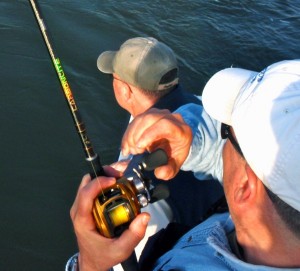 According to Wikipedia, sensitivity training is a method of behavioral modification that makes people more aware of their prejudices. Lately, I feel like I should be a little more sensitive. No, I don’t think I need to nicer to the trollers or more chivalrous to the ladies. I’m doing pretty good with those things. I’m thinking of the sensitivity I get when I have a jigging rod in my hands. When it comes to fishing, I want to be completely in-tune with my touchy-feely side.
According to Wikipedia, sensitivity training is a method of behavioral modification that makes people more aware of their prejudices. Lately, I feel like I should be a little more sensitive. No, I don’t think I need to nicer to the trollers or more chivalrous to the ladies. I’m doing pretty good with those things. I’m thinking of the sensitivity I get when I have a jigging rod in my hands. When it comes to fishing, I want to be completely in-tune with my touchy-feely side.
Due to the big crowds around the warm water discharges this spring, I’ve had plenty of opportunities to watch other light tackle fishermen in action. I’ve seen some very good anglers out there. On the other hand, I’ve noticed a few guys who have struggled. Other than disregarding the basic principles of stealth, the biggest mistake I see fishermen make is not feeling for their lures to touch the bottom when they’re jigging. Read More!
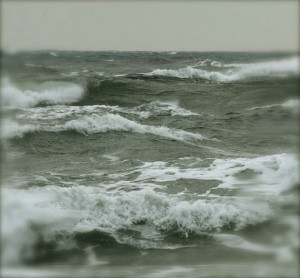 At least they must have been precious in his sight last weekend when an epic spring storm kept many fishermen off the Bay on the opening day of Maryland’s striped bass catch-and-kill season. Water temperatures are lower than usual this April, so there are lots of pre-spawn fish still moving up the Bay. I’d guess at least a couple of thousand more roe-laden cows made it to the spawning grounds this weekend that otherwise wouldn’t have, but for the storms. Let’s hope that translates into millions of additional baby rockfish. Even though I usually root for the fish, I still get excited about opening weekend because the recreational rockfish season in Maryland is definitely worth celebrating. With all the commercial poaching we saw this winter, it’s amazing to me that there are any fish left to catch. Since there are still a few around, let’s thank the Lord for that too!
At least they must have been precious in his sight last weekend when an epic spring storm kept many fishermen off the Bay on the opening day of Maryland’s striped bass catch-and-kill season. Water temperatures are lower than usual this April, so there are lots of pre-spawn fish still moving up the Bay. I’d guess at least a couple of thousand more roe-laden cows made it to the spawning grounds this weekend that otherwise wouldn’t have, but for the storms. Let’s hope that translates into millions of additional baby rockfish. Even though I usually root for the fish, I still get excited about opening weekend because the recreational rockfish season in Maryland is definitely worth celebrating. With all the commercial poaching we saw this winter, it’s amazing to me that there are any fish left to catch. Since there are still a few around, let’s thank the Lord for that too!
 If you’ve ever traveled to Memphis, Tennessee, chances are good that you visited the Peabody Hotel lobby to see the world-famous mallards march down the red carpet. It’s a time-honored tradition that dates back to the 1930s when a couple of hunters from Arkansas decided it would be funny to put some live ducks in the hotel’s indoor fountain. The famous Peabody Marching Mallards have appeared on The Tonight Show, Sesame Street, The Oprah Winfrey Show, in People magazine and even graced the pages of the Sports Illustrated Swimsuit Issue. If you read the Peabody’s website, you’ll find that those lucky ducks are raised by a local farmer who loans them to the hotel. What you won’t read is that the farmer who provides the Peabody ducks is also an excellent fisherman. I know that for a fact because I fished with him all week. Read More!
If you’ve ever traveled to Memphis, Tennessee, chances are good that you visited the Peabody Hotel lobby to see the world-famous mallards march down the red carpet. It’s a time-honored tradition that dates back to the 1930s when a couple of hunters from Arkansas decided it would be funny to put some live ducks in the hotel’s indoor fountain. The famous Peabody Marching Mallards have appeared on The Tonight Show, Sesame Street, The Oprah Winfrey Show, in People magazine and even graced the pages of the Sports Illustrated Swimsuit Issue. If you read the Peabody’s website, you’ll find that those lucky ducks are raised by a local farmer who loans them to the hotel. What you won’t read is that the farmer who provides the Peabody ducks is also an excellent fisherman. I know that for a fact because I fished with him all week. Read More!



